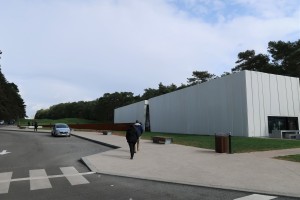
The Vimy Ridge Visitor Education Centre.
(P. Ferguson image, September 2017)
Three Soldiers of the 16th
In 2017 we journeyed to Vimy from Ieper (Ypres, Belgium). It was my first experience driving on the continent and although prepared (having a plan for the day) and filled with hopeful arrival times, we were not without diversion. In one instance, with the white towers of Vimy on the distant horizon, road construction, within a nearby town, directed us far off course and it was some while before we were on the recognized roadway to Vimy.
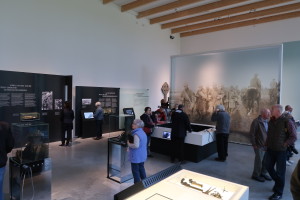
Visitors to the Vimy Ridge Visitor Education Centre.
(P. Ferguson image, September 2017)
We visited this day to see the new Vimy Ridge Visitor Education Centre inaugurated in April 2017 to coincide with the 100th anniversary of the battle (9-12 April 1917). Several others, many from Canada, were here amongst us wandering about the popular exhibit, a showcase of Canada’s Vimy experience. Allward and the memorial, traces of war, the personal, the context here amongst the chosen stories.
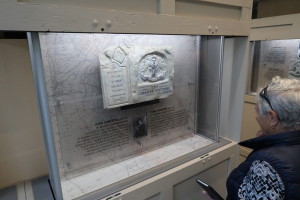
A visitor at the soldier’s graffiti exhibition, Souterraine Impressions.
(P. Ferguson image, September 2017)
However, in a temporary exhibition space that I happily came upon were modern casts of graffiti from nearby tunnels. Featuring soldier stories and their work, the “I was here” workings included those of Alvin Kines, Daniel Holmes (wounded at Vimy) and John Cameron (wounded at Vimy) all of the 16th Canadian Infantry Battalion (The Canadian Scottish).
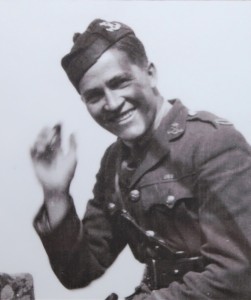
Alvin Kines
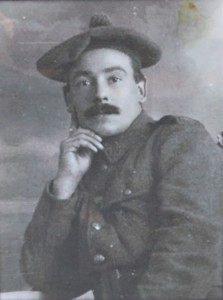
John Cameron
The project Souterraine Impressions represented the work of several underground would-be sculptors and carvers and grateful thanks to the Canadian Historical Documentation and Imaging Group (CANADIGM) who reproduced the soldier’s work as 3-D prints. Those of us fortunate to see the exhibit at Vimy could not help but think upon those who knew this this place well…Kines, Holmes, Cameron and others.
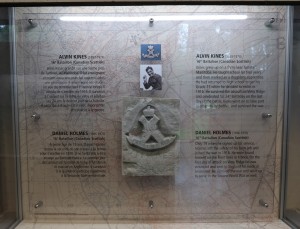
The work of Alvin Kines and Daniel Holmes.
We had chosen a good day to be car bound instead of on foot or pedal bike. Our visit to Vimy was accentuated by the onslaught of a hard rain. As torrents claimed any form of dry clothing I managed to wander towards the memorial and revisit with the figures that remain in steady contemplation. Man, woman with storm clouds above. Vimy is a fine place to visit in weather of all sorts and, as I have been known to mention…somehow it’s always seems better when it rains. Our trio of soldiers survived the war, perhaps their recollections once again brought to the fore by some time spent in 1917 cutting into the chalk of tunnels.
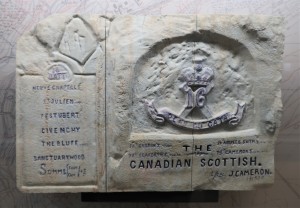
The work of John Cameron.
The Souterraine Impressions exhibition closed at Vimy in November 2017.
The exhibit had been on shown previously and continues to travel.
*An image of Daniel Holmes has not been traced.
Perhaps one day he will be here amongst his fellow carvers.
Tags: 16th Canadian Infantry Battalion (The Canadian Scottish), 3-D Printing, Alvin Kines, Canadian Historical Documentation and Imaging Group, CANADIGM, Chalk, Daniel Holmes, Graffiti, John Cameron, Souterraine Impressions, Tunnels, Vimy Ridge, Vimy Ridge Visitor Education Cemtre
This entry was posted by pferguson
on Friday, October 30th, 2020 at 7:00 pm and is filed under Art, Remember Them Well.
You can follow any responses to this entry through the RSS 2.0 feed.
You can leave a response, or trackback from your own site.
About The Author

Paul has worked with the Paradigm Motion Picture Company since 2009 as producer, historian and research specialist. Paul first met Casey and Ian WIlliams of Paradigm in April 2007 at Ieper (Ypres), Belgium when ceremonies were being held for the re-dedication of the Vimy Memorial, France.
Paul's sensitivity to film was developed at an early age seeing his first films at RCAF Zweibrucken, Germany and Sardinia. Paul returned to Canada in 1967 and was captivated by David Lean's "Lawrence of Arabia" and "Bridge on the River Kwai". Over time Paul became increasingly interested in storytelling, content development, character, direction, cinematography, narration and soundtracks.
At the University of Victoria, Paul studied and compared Japanese and Australian film and became interested in Australian film maker Peter Weir and his film "Gallipoli" (1981). Paul was inspired when he learned Weir visited the beaches, ridges and ravines of the peninsula. "Gallipoli", the film, led Paul on many journeys to sites of conflict in England, France, Belgium, Holland, Germany, Malta, Hawaii, Gallipoli, North Macedonia and Salonika.
When Paul first watched documentary filmmaker Ken Burns, "The Civil War", Paul understood how his own experience and insight could be effective and perhaps influential in film-making. Combining his knowledge of Museums and Archives, exhibitions and idea strategies with his film interests was a natural progression.
Paul thinks like a film-maker. His passion for history and storytelling brings to Paradigm an eye (and ear) to the keen and sensitive interests of; content development, the understanding of successful and relational use of collections, imagery and voice. Like Paul's favorite actor, Peter O'Toole, Paul believes in the adage “To deepen not broaden.”
While on this path Paul always remembers his grandmother whose father did not return from the Great War and how his loss shaped her life and how her experience continues to guide him.








Comments